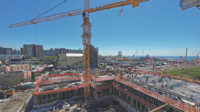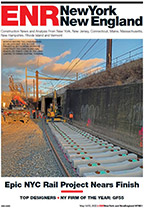Schiavone/Shea finished the Manhattan leg of the New York City Dept. of Environmental Protection�s City Water Tunnel No. 3 this May. A joint venture among John P. Picone of Lawrence, N.Y.; Schiavone; Frontier-Kemper; and Dragados is working on the $176 million shaft work, piping, valve and control contract.
Work continues on the Port Authority�s $3.2 billion World Trade Center Transportation Hub, which will create a new PATH station and connect to the Fulton Street Transit Center. Tishman/Turner, a joint venture of Tishman Corp. and Turner Construction Co., both of New York, is providing construction management support services.
DCM Erectors of New York, under a $338.8 million contract, is fabricating and erecting the structural steel to bring the Transportation Hub to grade.
A joint venture among Skanska Civil; Granite Construction Northeast of Tarrytown, N.Y.; and Skanska USA Building of New York, received a $542 million contract for construction of four rail platforms and the installation of heating, ventilation and air conditioning systems, plumbing work, fire protection and architectural finishes.
Tutor Perini is working on underpinning the No. 1 line underpass, a $177.6 million project considered critical to the hub, according to Port Authority spokesperson Steve Coleman.
Consequences Of So Much Work
While contractors agree all the underground work is good for business, it�s not without some challenges.
Almeraris notes that securing equipment and materials requires longer lead times and advance planning. Since most of the projects are part of larger programs with multiple contracts and numerous contractors, he adds, teams must coordinate with other entities at the contract limit interfaces and common access points.
For instance, Badame adds, the paths for the Trans-Hudson Express Tunnel and the Seventh Avenue Subway extension paths will cross. Badame says that is being fully planned for.
�Skilled craft, engineering and supervision are by far our greatest challenge,� adds Almeraris. The company is working three shift operations and weekends in most cases, which gives rise to concerns about craft-labor burnout.
�The talent pool is not endless and we have been forced to look nationwide for personnel resources,� Almeraris says. �The out-of-town workers required us to develop extensive training programs to train new employees and make sure they are fully integrated into Skanska�s safety culture. The learning curve has been especially long in the underground business, which relies a lot on experience, and this may result in many projects struggling to stay on schedule.�
Scagnelli says his firm has the talent to complete its jobs, but he agrees it�s becoming more difficult to find good people with the expertise, adding, �There has not been this much tunnel work in New York as far as I can remember.�
Useful Sources
div id="articleExtras"






